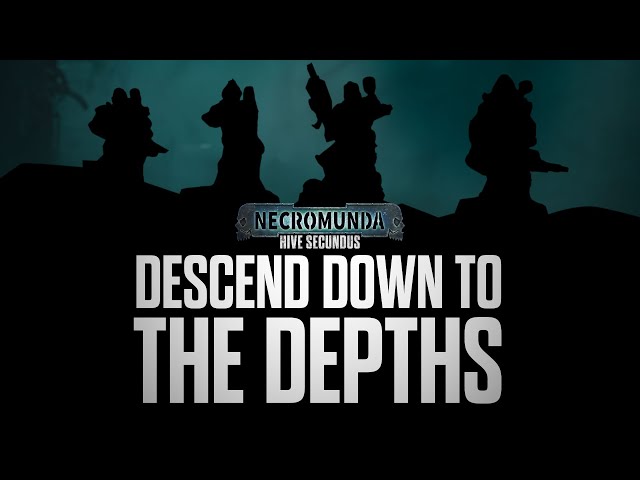I was lucky enough to get an early review copy of the new Necromunda: Hive Secundus box set from Games Workshop, and my main takeaway so far is that the rulebook contains the most high octane, heavy metal, grimdark Warhammer 40k lore I’ve read in years.
I love Warhammer 40k lore in all its forms. I’ve spent over 1,000 hours listening to Horus Heresy books and Warhammer 40k books on Audible, and one of the best parts of my day job is poring through Codexes to expand Wargamer’s lore guides to all the Warhammer 40k factions. But that has given me opinions on what makes 40k lore great.

The best Warhammer 40k lore exhibits some key features. It’s evocative, giving you a few juicy facts and more intriguing unanswered questions, so that your imagination goes into overdrive trying to fill in the blanks. It’s tragic, with terrible events ruining something that could have been beautiful.
It’s epic, giving larger than life characters massive stages to act on. And it melds the human and the inhuman, placing characters with recognisable human motivations in a context that’s completely unlike our real world.
The tragedy of Hive Secundus has all of those features and more besides. It was once the seat of learning and culture on Necromunda, its halls filled with glittering data crystals that survived from the dark age of technology.
Like most Necromunda supplements, there’s a timeline for this city dating back to the dawn of the Imperium, giving a sense of its long legacy and what is lost in its destruction.
The city’s downfall is the result of all-too human failings. The hubris of the Inquisition and Magos Hermiatus of the Adeptus Mechanicus allow a Genestealer Cult to take root in the city. Cowardice and self-interest slow the response by planetary governer Lord Cyar Helmawr, allowing the infection to run rampant.
The war for the hive is epic and melodramatic, as the citizens are first overrun by alien hybrids, then bombarded by encircling military forces. Lord Cyar is executed for negligence, and even the Space Marines can’t stop the threat.
Cyal’s son, Lord Kael Helmawr, orders the Eye of Selene space station to leave its geostationary orbit above Hive Primus for the first time in over a thousand years and unload a payload of gravity missiles into the Hive. Freaking gravity missiles!
All of this is just the backdrop justifying the coolest freaking dungeon setting in 40k. The exclusion zone around the ruined hive is girdled by a continuous military fortification, the Dust Wall, which guards constantly against Genestealer excursions.
Inside the Dust Wall are hundreds of miles of badlands, scoured by fallout from ancient superweapons, but populated by the descendants of refugees and military units trapped within the cordon when the bombs fell.
In the middle of that is a miles-deep pit called the Secundan Abyss. Descending means using one of a few, rickety lifts hauled by ancient cargo cranes. At the bottom of that pit are the crushed ruins of Hive Secundus, the Underhells. They’re crawling with mutant Malstrain genestealers, and suffused with the psychic aura of madness projected by the unseen Broodlord of the cult…
This is peak 40k. What’s written is heavy metal, and what’s unwritten sets you thinking. What secrets might still be trapped in the ancient data crystals left in the ruins? What is the true form of the Broodlord? Why does the Malstrain seem to repel the Tyranid Hive Mind? Was Magos Hermiatus truly onto something with his attempts to ‘cure’ the Genestealer curse?
Hive Secundus – like all of Necromunda – also gets to be really, really weird, because its characters and models only have to make sense in the context of one weird little world, not the galaxy-spanning battlefronts of 40k.
This is particularly visible in the model design, with upcoming monstrosities like the Malstrain Alpha and Malstrain Coalescence dialling up the incomprehensible horror in ways that regular Genestealers – exhaustively explained in several Codexes – just can’t be any more.

I enjoy intergalactic war stories and galaxy ending threats as much as the next 40k fanatic, but they are very thoroughly mapped out: there just aren’t that many secrets left. And the apocalyptic pitch of all the main conflicts in 40k at present also mean that while new 40k lore is always epic, it can rarely focus on the human or tragic aspects of the world. Necromunda can.
Don’t take this as a recommendation in and of itself to grab Hive Secundus: it seems like a good two-player entry point to Necromunda, but I haven’t tested the special campaign in it at all, so that’s just a gut feeling. But if you’re a 40k lore bunny, I do strongly recommend you check out Necromunda. The House books, Necromunda’s equivalent to Warhammer 40k Codexes, are dripping with high grade lore.
And if that description of Hive Secundus has you foaming, the Book of Desolation supplement comes with a multiplayer campaign that’s all about traversing the dust wall, the exclusion zone, and down into those hellish depths – you can read more about it here. I’ve got shivers already.
Source: Wargamer




